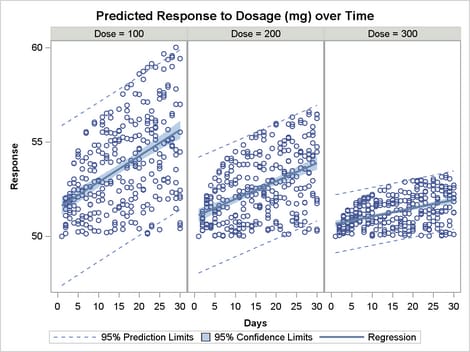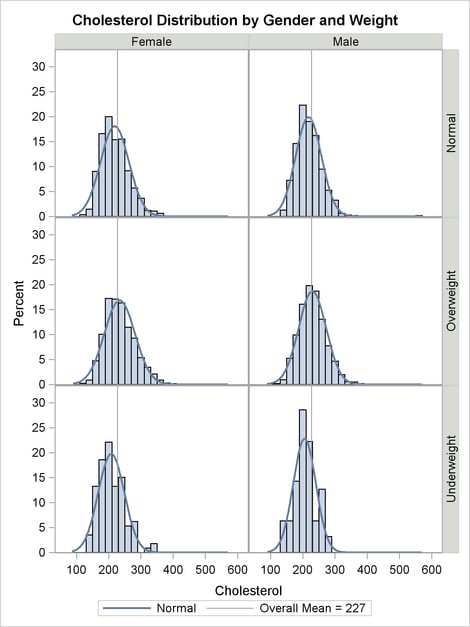Using PROC SGPANEL to Create Classification Panels
When creating
a panel like the one shown in Using Non-computed Plots in Classification Panels, you might
find it easier to create the panel by using PROC SGPANEL in SAS/GRAPH
because the procedure does all the necessary data computations for
you. For example, the REGRESSIONPLOT, LOESSPLOT, and PBSPLINEPLOT
statements have been incorporated into the SGPANEL procedure as REG,
LOESS, and PBSPLINE statements. (SGPANEL can also generate other plot
types.) By default on PROC SGPANEL, the PANELBY statement creates
a DATAPANEL layout.
ods listing style=statistical; title "Predicted Response to Dosage (mg) over Time"; proc sgpanel data=trial; panelby dose / rows=1; reg x=days y=response / cli clm; run;
Most,
but not all, features of the DATALATTICE and DATAPANEL layouts are
provided in the SGPANEL procedure.
The SGPANEL
procedure supports computed plot statements such as HISTOGRAM, DENSITY,
DOT, VBOX, and HBOX (vertical and horizontal box plots). The PANELBY
statement controls the layout, determining whether a DATAPANEL, DATALATTICE,
or other layout is used to produce the graph. ROWAXIS and COLAXIS
statements control the external axes, and the KEYLEGEND statement
creates legends, which are placed in sidebars for you.
The SGPANEL
procedure does not have a PROTOTYPE block because all of the plot
statements after PANELBY are considered part of the prototype. The
SGPANEL procedure generates GTL template code behind the scenes and
executes the template to create its output. See the SAS/GRAPH Statistical Graphics Procedures Guide documentation
for details.
ods listing style=statistical; title "Cholesterol Distribution by Gender and Weight"; proc sgpanel data=sashelp.heart; panelby sex weight_status / layout=lattice onepanel novarname; histogram cholesterol; density cholesterol / name="density"; refline 227 / axis=x name="ref" legendlabel="Overall Mean = 227"; rowaxis offsetmin=0 offsetmax=.1 max=30; keylegend "density" "ref"; run;

